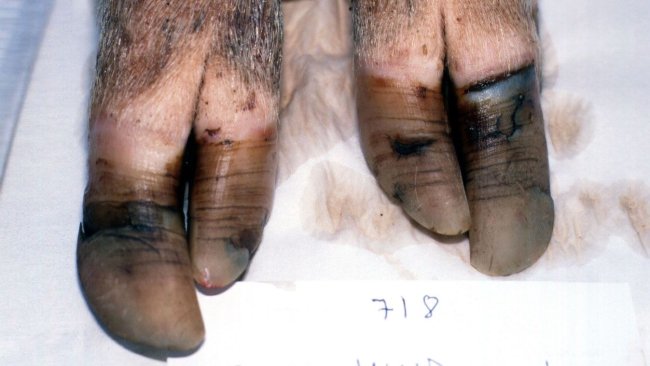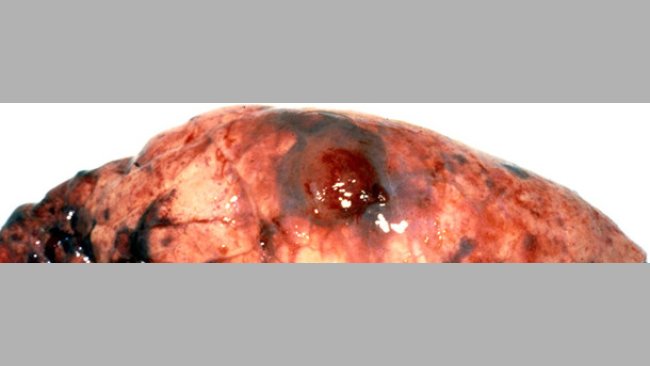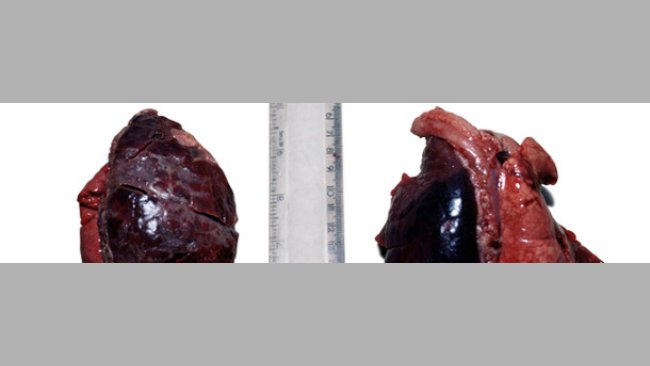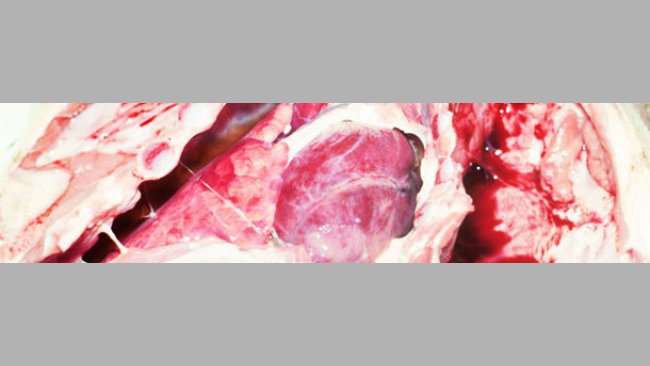
Clinical case: Overgrown claws and foot problems in sows
The overgrowth of horn of the claw leading to slipper feet, cracking or separation, and secondary septic laminitis has a multifactorial origin.
The pig sector events all around the world
Weekly newsletter with all the pig333.com updates
Swine industry news in your email
Pig health: news and articles on PRRS, PCV2, biosecurity, etc, Pig disease guide, atlas of pathology, clinical cases…
Biocheck.UGent is an independent, risk-based, scientific scoring system for assessing the quality of your on-farm biosecurity.
A visual and practical step-by-step guide on how to perform a necropsy on a pig.
All the information about ASF: how to recognize the disease, how it is transmitted, pictures of lesions, latest news, guides, etc.
All the information on Foot and Mouth Disease in pigs: how to recognize the disease, how it is transmitted, images of lesions, latest news, guides,...
Description of the most important diseases and conditions in pigs
Images of major swine diseases
Pig disease diagnostic tool
Definition for the most commonly used pig terms
Simulator that calculates the amount of drug to add to the water when using a flow dispenser.
Weekly newsletter with all the pig333.com updates
Pig Prices by countries. Pork production and trade. News of the pig market and the raw materials
The latest slaughter pig prices in the most important pig markets. Check the evolution of the historical prices in charts and in several currencies.
Latest quotations for the main commodities used in pig feed. Historical graphs with the pig price and estimated feed price.
Figures & trends in pig numbers, pork production and pork trade.
Global production and trade data for the most important raw materials
Weekly newsletter with all the pig333.com updates
Articles on nutrition and pig feeding, characteristics of raw materials and additives for pig feed. Prices of raw materials
Latest quotations for the main commodities used in pig feed. Historical graphs with the pig price and estimated feed price.
Technical sheets of the main raw materials and additives used in swine feed. They include a comparison of nutritional values from various sources, product
Global production and trade data for the most important raw materials
Definition for the most commonly used pig terms
Use this tool to diagnose problems with the feed conversion ratio. Click on the flowchart or on the buttons within the text to navigate through the different parts of the tool.
A biweekly newsletter with the latest developments in swine nutrition
Articles on genetics and pig reproduction: genetic improvement, genomics, artificial insemination, use of hormones
Compare production data, calculate the number of sow, nursery, and finishing spaces, and visualize your tasks on the work schedule by type of BMS.
Tool that allows you to calculate the replacement rate in your farm
Definition for the most commonly used pig terms
Use this tool to find out why your farrowing rate is less than ideal. Click on the flowchart or on the buttons found within the text to navigate through the different parts of the tool.
Weekly newsletter with all the pig333.com updates
Management, pig farm management, work planning in each production stage: management in gestation, grow finish, batch farrowing
Compare production data, calculate the number of sow, nursery, and finishing spaces, and visualize your tasks on the work schedule by type of BMS.
Tool that allows you to calculate the replacement rate in your farm
Definition for the most commonly used pig terms
Weekly newsletter with all the pig333.com updates
Design of facilities and equipment for pig farms: building design, climate control, feeding systems, etc.
Biocheck.UGent is an independent, risk-based, scientific scoring system for assessing the quality of your on-farm biosecurity.
Environmental Footprint Calculator along the pork value chain.
Definition for the most commonly used pig terms
Simulator that calculates the amount of drug to add to the water when using a flow dispenser.
Use this tool to explore which slurry management strategy best fits your situation. Click on the flow chart or on the buttons within the text to navigate through the different parts of the tool.
Weekly newsletter with all the pig333.com updates
What makes us stand out is the quality and independence of our contents. Find out about the authors who make it possible. Our goal is to generate a virtual community of advanced users in the sector.

The author is a pig specialist veterinary surgeon who spent more than 30 years, following graduation from the University of Bristol, as a Partner in a large mixed practice in Yorkshire. Since retiring from the Practice in 2013 he has worked as an independent veterinary consultant to the pig industry.
Over the years he has provided advice to pig farmers around the world with emphasis on pig health maintenance and restoration, welfare and productivity. Training of both stock people and young veterinarians has formed an important part of the job. He has written extensively on clinical and practical pig matters for both veterinary and farming audiences.
He is a Past President of the Pig Veterinary Society and currently serves on its medicines sub-committee and is a member of the Royal College of Veterinary Surgeons Advanced Practitioner Panel
He was a co- organiser of the highly successful 1998 IPVS Congress in Birmingham UK and chaired the organising committee of the 5th ESPHM 2013 Edinburgh.
He is a current member of the UK Government’s Farm Animal Welfare Committee.
In 2005 he completed a Bachelor of Laws degree studying part-time at the University of Hull and undertakes expert witness work in both criminal and civil cases that relate to pig medicine and pig keeping.
He has been married for 32 years, has 2 adult sons and now lives in rural Herefordshire.
Updated CV 25-Aug-2014

The overgrowth of horn of the claw leading to slipper feet, cracking or separation, and secondary septic laminitis has a multifactorial origin.

Great care is needed particularly when handling young pigs above 6kg/3 weeks of age, to avoid causing lasting damage.

Captive bolt humane stunners do not kill larger growing pigs or adults, they render the pig unconscious. Further action is needed to ensure the pig is dead.

This case study describes an outbreak in a commercial unit which proved difficult to stop without vaccine. Since 2014 an increasing number of cases of this disease have been reported in Europe though it remains unclear why it has reappeared.

It has not proved possible to actively eliminate App from chronically affected permanently occupied breeder-feeder herds.

This paper describes the acute outbreak of App within a pig population and how control may be achieved.

At least 25% of the pigs from 2 to 3 weeks old were reported to be lame, some so severe that they lay in the arcs shaking and unable to stand.

This clinical case study tracks the long term pattern and control of Actinobacillus pleuropneumoniae (App) disease in a breeder feeder farm through the 1990’s.

Well intentioned treatment of piglets at birth may adversely affect the normal early nasopharyngeal or tonsil colonisation making pigs vulnerable to respiratory infections due to potential pathogens present within the herd.
Welcome to 333
Connect, share, and interact with the largest community of professionals in the swine industry.
Celebrating 196578Users on 333!
Sign upAlready a member?





